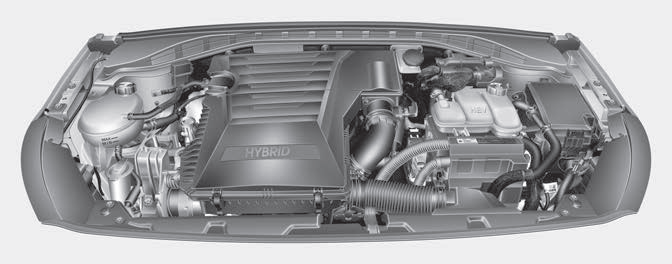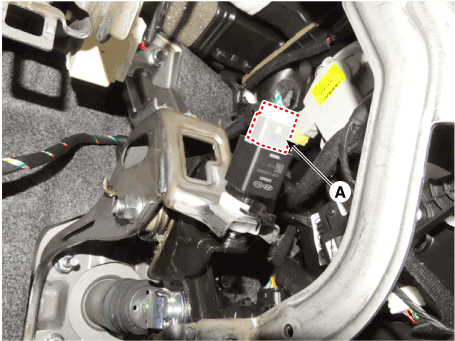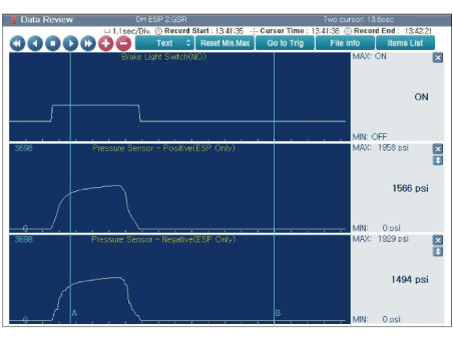Hyundai Ioniq: Brake System / Stop Lamp Switch. Repair procedures
Hyundai Ioniq (AE) 2017-2025 Service Manual / Brake System / Brake System / Stop Lamp Switch. Repair procedures
| Removal |
| 1. | Turn ignition switch OFF and disconnect the negative (-) battery cable. |
| 2. | Remove the lower crash pad. (Refer to Body - "Crash Pad") |
| 3. | Remove the knee airbag. (Refer to Rstraint - "Air Bag Module") |
| 4. | Disconnect the stop lamp switch connector (A).
|
| 5. | Pull the locking plate (A) as indicated by the arrow.
|
| 6. | Turn stop lamp switch 45° counterclockwise and remove it.
|
| 7. | Inspect a removed stop lamp switch along the below procedures.
|
| Installation |
| 1. | Fix the brake pedal arm and insert fully the stop lamp switch as hiding contact part. Turn stop lamp switch 45° clockwise and install it.
|
| 2. | Assemble locking plate (A) by pushing.
|
| 3. | Confirm the gap between stop lamp switch and bracket.
|
| 4. | Connect the stop lamp switch connector.
|
| 5. | Remove the knee airbag. (Refer to Rstraint - "Air Bag Module") |
| 6. | Install the lower crash pad. (Refer to Body - "Crash Pad") |
| 7. | Connect the negative (-) battery cable. |
| Adjustment |
| 1. | Turn ignition switch OFF and disconnect the negative (-) battery cable. |
| 2. | Remove the lower crash pad. (Refer to Body - "Crash Pad") |
| 3. | Remove the knee airbag. (Refer to Rstraint - "Air Bag Module") |
| 4. | Confirm the gap between stop lamp switch and bracket.
|
| 5. | If the gap between stop lamp switch and bracket is not 1.0 - 2.0 mm (0.04 - 0.08 in), check the mounting clip and other part of around stop lamp. |
| 6. | If there is normal, remove the stop lamp switch and then install again. |
| Inspection |
1. Fuse Inspection
Mount the test fuse to the switch fuse and relay fuse part to confirm a normal joint fit.


2. GDS Data Analysis
| 1. | Analyze GDS data and confirm if there is anything wrong with the stop lamp switch.
|
3. Inspection Of Connector By Each Part
Check to see whether or not each connector has been damaged, or terminal surge, or incomplete connection has taken place
[Engine Room Junction Box]

[ABS / VDC Control Module]

4. Inspect The Stop Lamp Circuit
Connect probe to each terminal wire and confirm oscilloscope waveform.
[Stop Lamp Switch Input / Output]

[Oscilloscope Waveform Screen]

 Stop Lamp Switch. Troubleshooting
Stop Lamp Switch. Troubleshooting
Troubleshooting1. Part diagnosis Items Cause Symptom Switch fuse Faulty fuse connection, Damaged fuse –
DTC Code : P0504–
Symptom : Shifting gear trouble, Starting failure, Cruise control function cancelation trouble, EPB function cancelation trouble, Stop lamp lighting trouble, ESP OFF light illuminated...
Other information:
Hyundai Ioniq (AE) 2017-2025 Owner's Manual: FCA Warning Message and System Control
The FCA produces warning messages and warning alarms in accordance with the collision risk levels, such as abrupt stopping of the vehicle in front, insufficient braking distance, or pedestrian detection. Also, it controls the brakes in accordance with the collision risk levels...
Hyundai Ioniq (AE) 2017-2025 Service Manual: Tailgate Latch. Components and components location
C..
Categories
- Manuals Home
- 1st Generation Ioniq Owners Manual
- 1st Generation Ioniq Service Manual
- Smart Cruise Control System
- Folding the side view mirrors
- Towing
- New on site
- Most important about car
Hybrid Vehicle Engine Compartment

1. Engine oil filler cap
2. Engine oil dipstick
3. Engine coolant cap
4. Engine coolant reservoir
5. Inverter coolant reservoir
Copyright © 2025 www.hioniqae.com










